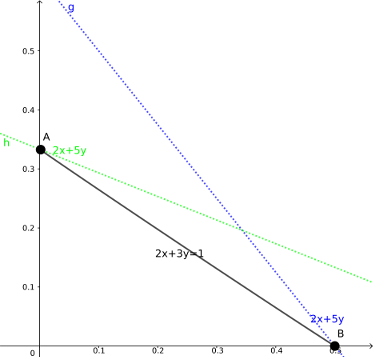Consider the following optimization problem, with $n$ variables and $m$ linear constraints: \begin{align} \text{maximize} && c_1 x_1 + \cdots + c_n x_n & \\ \text{subject to} && a_{11} x_1 + \cdots + a_{1n} x_n &= b_1 \\ && a_{21} x_1 + \cdots + a_{2n} x_n &= b_2 \\ &&... \\ && a_{m1} x_1 + \cdots + a_{mn} x_n &= b_m \\ && x_1 \ldots,x_n &\geq 0 \end{align} It is known that, if the problem has an optimal solution, then it has an optimal solution in which at most $m$ variables are non-zero; it is called an optimal basic feasible solution.
This can be easily visualized in two dimensions ($n=2$). For example here:
the solid black segment represents the single constraint ($m=1$), and the two dotted lines represent two different objectives; it is clearly visible that each objective is both maximized and minimized at one of the endpoints of the segments, which has at most one nonzero.
This nice property holds, in some cases, even if the constraints are not linear. For example, in the above case, if we raise the variables in the constraint to a power smaller than 1, then the linear objectives are still maximized (but not minimized) at the endpoints:
MY QUESTION IS: is this true in general? I.e., is it true that, if we replace each term $a_{ij}x_i$ in the above program with a term $f_{ij}(x_i)$, where $f_{ij}$ is a concave function (such as $f_{ij}(x_i) = (x_i)^{0.7}$), then there is still an optimal solution with at most $m$ nonzeros?
Note: posted previously on math.SE with no replies.


